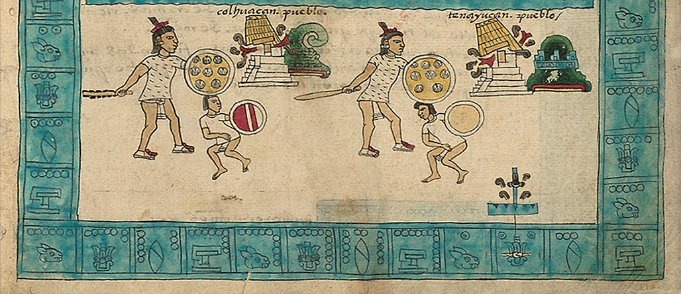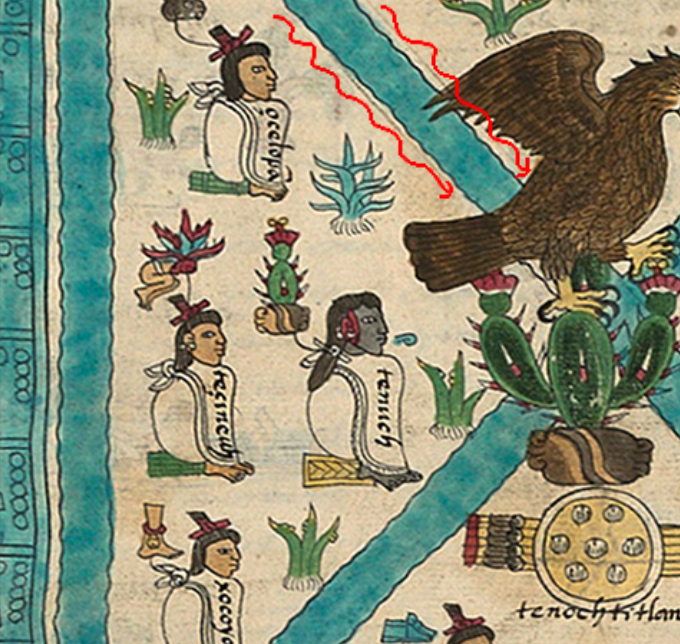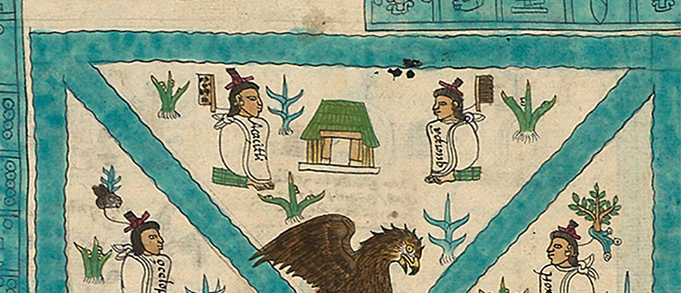APAH - Early Colonial Americas
Frontispiece of the Codex Mendoza
(Codex Mendoza) date: CE. 1541 - 1542
(Codex Mendoza) PATRON: Antonio de Mendoza
(Codex Mendoza) Original location: Tenochtitlan (Modern day Mexico City).
(Codex Mendoza) Artist: Francisco Gualpuyogualcal (many artists work on other pages; Francisco in particular mainly worked on the Frontispiece)
(Codex Mendoza) Materials/techniques: manuscript, folio, hierarchical scale, paper, ink and pigment, stylized, two-dimensional, undulating
History:
Antonio de Mendoza (first viceroy of New Spain A.K.A Mexico) commissioned the Codex Mendoza to document the growth and details of Tenochtitlan to report back to Emperor Charles V of Spain in 1541.
- viceroy: a ruler exercising authority in a colony on behalf of a sovereign. (Basically a representative of his or her’s sovereign/king, and is in power to act in the sovereign’s name; representatives who can use their power under their sovereign or king’s name).
the Nahuas spoke in Nahuatl.
However, the Codex Mendoza ended up in the hands of French pirates, then to King Henry II’s cosmographer André Thevet, during sixteenth-century France.
The Frontispiece of the Codex Mendoza belonged to a folio of other documentations of the Aztec empire. (indicated by Thevet’s name, written on top of the Codex)
Important figures:
Spain:
- Antonio de Mendoza (first viceroy of New Spain)
- Emperor Charles V of Spain
France:
- André Thevet (royal cosmographer)
- King Henry II
Aztecs / Tenochtitlan:
- Francisco Gualpuyogualcal
- Ten Founders
- Huitzilopochtli (Aztec Hummingbird deity)
- Tenoch (member of the Ten Founders; a priest indicated by the gray skin and blood from his ear)
- Colhuacan and Tenoyucan tribes
Content:
- included information of Aztec leaders (Ten Founders of Tenochtitlan can be found surrounded by the lake in four quadrants; indicated by their own sign or glyph and annotations in Spanish).
- the Ten Founders are leaders who led the Aztecs to Tenochtitlan.
- Huitzilopochtli prophesied the new locations for the Aztecs; the Aztecs must build their place when they see an eagle land on a Nopal (the prickly pear cactus).
- the artist/artists of the Codex Mendoza are indigenous by it’s unique style, with annotations in Nahuatl.
- The Codex Mendoza documented the mythical origins of the Aztec capital that is located in the middle of Lake Texcoco: Tenochtitlan. It is also known as modern day Mexico City. (indicated by the prickly pear cactus in the middle and the eagle on top of it).
Conquest:
Bottom of the Codex Mendoza: Tenochtitlan warriors as indicated by their war shields, can be spotted and is depicted to be much larger (hierarchical scale) to demonstrate Tenochtitlan’s victory over other tribes (Colhuacan and Tenayuca).

Function:
- The Codex Mendoza acts as a map of Tenochtitlan.
- A lot of symbols were used, such as the prickly cactus in the middle is symbolic of the same prickly cactus that grew in the middle of Lake Texcoco.
- Huitzilopochtli is a humming bird deity; can be spotted on the left near the eagle.
- Nopal: prickly pear cactus indigenous to Mexico City. Grows from a stone.
Map layout of the Codex Mendoza:
Water canals of Lake Texcoco:
the city of Tenochtitlan is divided into four intersecting blue/green or turquoise with a undulating/wavy outline. (Represents water canals).
City Layout:
a temple can be spotted above the eagle, and a shield below the eagle (shield represented the fact that the people of Tenochtitlan had to fight for this territory).
The temple itself can be an indication of an early build of an Aztec temple called Templo Mayor.
a skull rack (tzompantli) can be spotted near the temple.
water canals aligns with the Four Cardinal Directions
different plants like maize (corn, a plant also indigenous to Mexico) is laid out around the city’s four quadrants.
- ^^note: was the actual city really laid out into four quadrants? or was only made for easy-view?^^
\
(Codex Mendoza) Summary:
The Codex Mendoza is a folio manuscript that utilizes animal symbolism and stylized, two-dimensional and bright-colored figures to tell the mythical origins of how the Aztecs settled into Tenochtitlan, also known as modern day Mexico City. The Codex Mendoza was commissioned by a viceroy of New Spain, Antonio de Mendoza, to help document the growth and details of the new Aztec capital of Tenochtitlan as a report back to King Charles V at Spain. Furthermore, this folio depicts the city of Tenochtitlan into four-quadrants, divided by diagonal turquoise borders with undulating outline. These turquoise borders represents the water canals of the city. In fact, the Ten Founders of Modern day Mexico is layed around the map, and some of them grouped in a quadrant. This folio is evident that the Tenochtitlan had to fight other tribes in order to settle down in Lake Texcoco (as indicated by the war shield in the middle of the Codex Mendoza), and the Conquest portion on the bottom half of the Codex mendoza.


